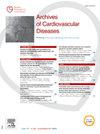Heart failure therapeutic units: Prognostic impact
IF 2.3
3区 医学
Q2 CARDIAC & CARDIOVASCULAR SYSTEMS
引用次数: 0
Abstract
Introduction
Heart failure (HF) continues to be a prevalent condition with high morbidity and mortality despite numerous therapeutic advances. Thus, we created a Heart Failure Therapeutic Unit (HFTU) to optimize medical treatment promptly.
Objective
Primary objective: to study the impact of the HFTU on reducing cardiovascular mortality and heart failure rehospitalizations at 1 year. Secondary objectives: to study the impact of the HFTU on treatment dose optimization and patient therapeutic adherence.
Method
We conducted a prospective, longitudinal, and single-center study at our cardiology department, with a follow-up period of 1 year. We included 159 patients with chronic HF (108 were included in the HFTU group and 51 in the control group). Patients included in the HFTU group received more frequent follow-up, early initiation of medical treatment with rapid progression to optimal doses, and transition to second-line treatments if there was no improvement and if indicated. The control group received standard care.
Results
The average age was 62.5 ± 11.7 years, with a male predominance (80.5%), and a high prevalence of diabetes (44%); ischemic cardiomyopathy was the dominant etiology (57.9%), with a mean left ventricular ejection fraction (LVEF) of 31.6 ± 8%. The most common inclusion criterion in the HFTU group was the absence of optimal medical treatment (97.2%). We observed a significant reduction in cardiovascular mortality and HF rehospitalizations at 1 year, as well as a significant decrease in HF rehospitalizations at 1 year in the UTIC group compared to the control group (15.7% vs 41.2%; P < 0.001; 11.1% vs 35.3%; P < 0.001 respectively), regardless of age, gender, and comorbidities (P < 0.001). Acquisition of optimal medical treatment (P < 0.001) and therapeutic adherence (P = 0.015) were more frequent in the HFTU group. We noted an improvement in dyspnea (P = 0.003), in LVEF (from ≤ 40% to > 40%) (P < 0.001) and in heart rate control (HR < 70 bpm) (P < 0.001) in the HFTU group compared to the control group.
Conclusion
HFTU was associated with a significant reduction in the combined endpoint of cardiovascular mortality and heart failure rehospitalizations, as well as a decrease in heart failure rehospitalizations. Additionally, it was associated with more therapeutic optimization and adherence, and an improvement in symptoms, LVEF, and heart rate control.
心力衰竭治疗单位:预后影响
心衰(HF)仍然是一种发病率和死亡率高的普遍疾病,尽管有许多治疗进展。因此,我们创建了心力衰竭治疗单位(HFTU),以及时优化医疗。目的:研究HFTU对降低1年心血管死亡率和心力衰竭再住院率的影响。次要目的:研究HFTU对治疗剂量优化和患者治疗依从性的影响。方法我们在我院心内科进行了一项前瞻性、纵向、单中心研究,随访1年。我们纳入了159例慢性HF患者(HFTU组108例,对照组51例)。HFTU组的患者接受了更频繁的随访,早期开始药物治疗,迅速进展到最佳剂量,如果没有改善,如果有指示,则过渡到二线治疗。对照组接受标准治疗。结果患者平均年龄62.5±11.7岁,男性居多(80.5%),糖尿病患病率较高(44%);缺血性心肌病为主要病因(57.9%),平均左室射血分数(LVEF)为31.6±8%。HFTU组中最常见的入选标准是缺乏最佳药物治疗(97.2%)。我们观察到,与对照组相比,UTIC组1年内心血管死亡率和心衰再住院率显著降低,1年内心衰再住院率显著降低(15.7% vs 41.2%;P & lt;0.001;11.1% vs 35.3%;P & lt;0.001),与年龄、性别和合并症无关(P <;0.001)。获得最佳医疗服务(P <;0.001)和治疗依从性(P = 0.015)在HFTU组更常见。我们注意到呼吸困难的改善(P = 0.003), LVEF(从≤40%到>;40% (P <;0.001)和心率控制(HR <;每分钟70分钟);0.001), HFTU组与对照组比较。结论hftu与心血管死亡率和心力衰竭再住院率的联合终点显著降低以及心力衰竭再住院率的降低相关。此外,它与更多的治疗优化和依从性以及症状、LVEF和心率控制的改善有关。
本文章由计算机程序翻译,如有差异,请以英文原文为准。
求助全文
约1分钟内获得全文
求助全文
来源期刊

Archives of Cardiovascular Diseases
医学-心血管系统
CiteScore
4.40
自引率
6.70%
发文量
87
审稿时长
34 days
期刊介绍:
The Journal publishes original peer-reviewed clinical and research articles, epidemiological studies, new methodological clinical approaches, review articles and editorials. Topics covered include coronary artery and valve diseases, interventional and pediatric cardiology, cardiovascular surgery, cardiomyopathy and heart failure, arrhythmias and stimulation, cardiovascular imaging, vascular medicine and hypertension, epidemiology and risk factors, and large multicenter studies. Archives of Cardiovascular Diseases also publishes abstracts of papers presented at the annual sessions of the Journées Européennes de la Société Française de Cardiologie and the guidelines edited by the French Society of Cardiology.
 求助内容:
求助内容: 应助结果提醒方式:
应助结果提醒方式:


